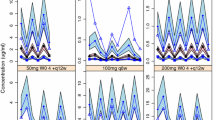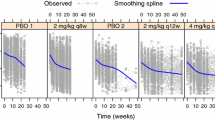Abstract
Informative exposure–response modeling of clinical endpoints is important in drug development. There has been much recent progress in latent variable modeling of ordered categorical endpoints, including the application of indirect response (IDR) models and accounting for residual correlations between multiple categorical endpoints. This manuscript describes a framework of latent-variable-based IDR models that facilitate easy simultaneous modeling of a continuous and a categorical clinical endpoint. The model was applied to data from two phase III clinical trials of subcutaneously administered ustekinumab for the treatment of psoriatic arthritis, where Psoriasis Area and Severity Index scores and 20, 50, and 70 % improvement in the American College of Rheumatology response criteria were used as efficacy endpoints. Visual predictive check and external validation showed reasonable parameter estimation precision and model performance.






Similar content being viewed by others
References
Dayneka NL, Garg V, Jusko WJ (1993) Comparison of four basic models of indirect pharmacodynamic responses. J Pharmacokinet Biopharm 21(4):457–478
Felson DT, Anderson JJ, Boers M et al (1995) American College of Rheumatology. Preliminary definition of improvement in rheumatoid arthritis. Arthritis Rheum 38(6):727–735
Hutmacher MM, Krishnaswami S, Kowalski KG (2008) Exposure–response modeling using latent variables for the efficacy of a JAK3 inhibitor administered to rheumatoid arthritis patients. J Pharmacokinet Pharmacodyn 35:139–157
Lacroix BD, Lovern MR, Stockis A, Sargentini-Maier ML, Karlsson MO, Friberg LE (2009) A pharmacodynamic Markov mixed-effects model for determining the effect of exposure to certolizumab pegol on the ACR20 score in patients with rheumatoid arthritis. Clin Pharm Therap 86(4):387–395.
Hu C, Xu Z, Rahman MU, Davis HM, Zhou H (2010) A latent variable approach for modeling categorical endpoints among patients with rheumatoid arthritis treated with golimumab plus methotrexate. J Pharmacokinet Pharmacodyn 37(4):309–321
Hu C, Xu Z, Mendelsohn A, Zhou H (2013) Latent variable indirect response modeling of categorical endpoints representing change from baseline. J Pharmacokinet Pharmacodyn 40(1):81–91
Hu C, Szapary PO, Yeilding N, Zhou H (2011) Informative dropout modeling of longitudinal ordered categorical data and model validation: application to exposure–response modeling of physician’s global assessment score for ustekinumab in patients with psoriasis. J Pharmacokinet Pharmacodyn 38(2):237–260
Hu C, Yeilding N, Davis HM, Zhou H (2011) Bounded outcome score modeling: application to treating psoriasis with ustekinumab. J Pharmacokinet Pharmacodyn 38(4):497–517
An X, Bentler PM (2011) Extended mixture factor analysis model with covariates for mixed binary and continuous responses. Stat Med 30:2634–2647
Laffont CM, Fink M, Gruet P, King JN, Seewald W, Concordet D (2012) Application of a new method for multivariate analysis of longitudinal ordinal data testing robenacoxib in canine osteoarthritis. PAGE 21 Abstr:2548
Beal SL, Sheiner LB, Boeckmann A, Bauer RJ (2009) NONMEM user’s guides (1989–2009). Icon Development Solutions, Ellicott City
Hu C, Zhou H (2008) An improved approach for confirmatory phase III population pharmacokinetic analysis. J Clin Pharmacol 48:812–822
Hu C, Zhang J, Zhou H (2011) Confirmatory analysis for phase III population pharmacokinetics. Pharm Stat 10(7):812–822
Zhu Y, Hu C, Lu M, Liao S, Marini JC, Yohrling J, Yeilding N, Davis HM, Zhou H (2009) Population pharmacokinetic modeling of ustekinumab, a human monoclonal antibody targeting IL-12/23p40, in patients with moderate to severe plaque psoriasis. J Clin Pharmacol 49(2):162–175
Zhang L, Beal S, Sheiner L (2003) Simultaneous vs. sequential analysis for population PK/PD data I: best-case performance. J Pharmacokinet Pharmacodyn 30:387–404
Karlsson MO, Holford NHG (2008) A tutorial on visual predictive checks. PAGE 17:2008
Hutmacher MM, French JL, Krishnaswamib S, Menonb S (2011) Estimating transformations for repeated measures modeling of continuous bounded outcome data. Stat Med 30:935–949
Hu C, Sale M (2003) A joint model for nonlinear longitudinal data with informative dropout. J Pharmacokinet Pharmacodyn 30(1):83–103
Woo S, Pawaskar D, Jusko WJ (2009) Methods of utilizing baseline values for indirect response models. J Pharmacokinet Pharmacodyn 36:381–405
Acknowledgments
The authors thank the Medical Affairs Publication Group of Janssen Scientific Affairs, LLC for their excellent editorial support.
Author information
Authors and Affiliations
Corresponding author
Appendices
Appendix
The lognormal latent variable model derivation and a NONMEM code to implement the conditional approach are given below.
Lognormal latent variable model for categorical data
For the ACR variable defined in METHODS, let L(t) be the latent variable and γk, k = 1, 2, 3 be the thresholds such that
Assuming the latent L(t) as positive and modeled as
where ε ~ N(0, 1) and σ is the error standard deviation. Then
Write βk = log(γk)/σ, then:
Note here that if log[M(t)] contains no proportional constant parameters, then σ = 1 may not be assumed. In this form, it is convenient to incorporate placebo effect multiplicatively as M(t) = fp(t) fd(t). Let R0 = fd(0), this leads to
Write αk = βk − log(R0)/σ, gp(t) = −log[fp(t)]/σ, De = 1/σ, and gd(t) = fd(t)/R0, the above becomes:
where gd(0) = 1. As in Eq. 2, BSV may be modeled at the intercept level with η ~ N(0, ω2), The placebo model gp(t) may still be empirically chosen, e.g., as the reduced model Eq. 4. A convenient choice of the drug model term gd(t) is the class of the baseline-normalized IDR models [6, 19]
where H1(t) and H2(t) indicate the corresponding inhibitory/stimulator term in the IDR model.
The lognormal latent variable model (Eq. 16) differs from the normal latent variable model (Eqs. 2–3) in that the last term as the drug effect is included in the model under a log-transformation. Both models have the same number of parameters, which can be seen, e.g., when a Type I IDR model is used, by comparing Eqs. 16–17 with Eqs. 6–7.
NONMEM Code and Data Format
An illustrative NONMEM code is given below along with the data format used. The dataset has ACR and PASI observations on the same line, and a variable FLGDVJ is used to indicate whether any of ACR and PASI observations is missing.




Rights and permissions
About this article
Cite this article
Hu, C., Szapary, P.O., Mendelsohn, A.M. et al. Latent variable indirect response joint modeling of a continuous and a categorical clinical endpoint. J Pharmacokinet Pharmacodyn 41, 335–349 (2014). https://doi.org/10.1007/s10928-014-9366-0
Received:
Accepted:
Published:
Issue Date:
DOI: https://doi.org/10.1007/s10928-014-9366-0




